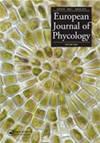Buoyancy control of Microcystis using different light regimes combined with extracellular polysaccharides and cationic ions
IF 1.7
4区 生物学
Q2 MARINE & FRESHWATER BIOLOGY
引用次数: 0
Abstract
ABSTRACT Cyanobacterial blooms are widely known to cause problems in the aquatic environment, and their appearance has become more frequent due to global warming. Microcystis is one of the most widespread and dominant bloom-forming cyanobacterial genera, largely because Microcystis has the ability to control its buoyancy. A buoyancy experiment conducted on Microcystis sp. isolated from cyanobacterial blooms in Lake Senba, Japan, showed that buoyancy could be controlled using a combination of preculture under the dark conditions and the addition of powdered tightly bound extracellular polysaccharides (TB-EPS) and metal cations (Ca2+ and Mg2+). Preculture under the dark conditions, 96 h in length were the most effective treatment to reduce the cellular carbohydrate content of Microcystis and simultaneously increase its buoyancy. The addition of TB-EPS, Ca2+ and Mg2+ ions increased the colony size of Microcystis and enhanced buoyancy in precultures under both dark and light conditions. Thus, the buoyancy of Microcystis can be controlled by reducing its cellular carbohydrate content by preculturing it in dark conditions for 96 h and increasing the colony size with the addition of 100 mg l−1 EPS, 80 mg l−1 Ca2+ and 80 mg l−1 Mg2+. This study contributes to establishing a novel removal method for cyanobacterial blooms dominated by Microcystis, especially in water treatment facilities. HIGHLIGHTS • Microcystis buoyancy was controlled by decreasing cellular carbohydrate content using preculture under dark conditions. • The addition of TB-EPS, Ca2+ and Mg2+ ions increased the colony size of Microcystis and enhanced the buoyancy in precultures under both dark and light conditions. • This represents a novel removal method for cyanobacterial blooms in water treatment facilities.不同光照条件下胞外多糖和阳离子离子对微囊藻浮力的控制
本文章由计算机程序翻译,如有差异,请以英文原文为准。
求助全文
约1分钟内获得全文
求助全文
来源期刊

European Journal of Phycology
生物-海洋与淡水生物学
CiteScore
4.80
自引率
4.20%
发文量
37
审稿时长
>12 weeks
期刊介绍:
The European Journal of Phycology is an important focus for the activities of algal researchers all over the world. The Editors-in-Chief are assisted by an international team of Associate Editors who are experts in the following fields: macroalgal ecology, microalgal ecology, physiology and biochemistry, cell biology, molecular biology, macroalgal and microalgal systematics, applied phycology and biotechnology. The European Journal of Phycology publishes papers on all aspects of algae, including cyanobacteria. Articles may be in the form of primary research papers and reviews of topical subjects.
The journal publishes high quality research and is well cited, with a consistently good Impact Factor.
 求助内容:
求助内容: 应助结果提醒方式:
应助结果提醒方式:


